In my continued effort to not have this blog turn into one of those sites where the blogger starts a pattern line and never talks about anything but her patterns ever again, I present my latest totally-not-Scroop-related* historical sewing make:

A 1780s bum rump!
To make my bum rump I referred to:
- The tutorial in The American Duchess Guide to 18th Century Dressmaking; plus
- Demode’s excellent post exploring late 18th century skirt supports; plus
- Extant images and mentions
The American Duchess book has a great tutorial on making a 1780s bum rump, and I used it as my starting point.
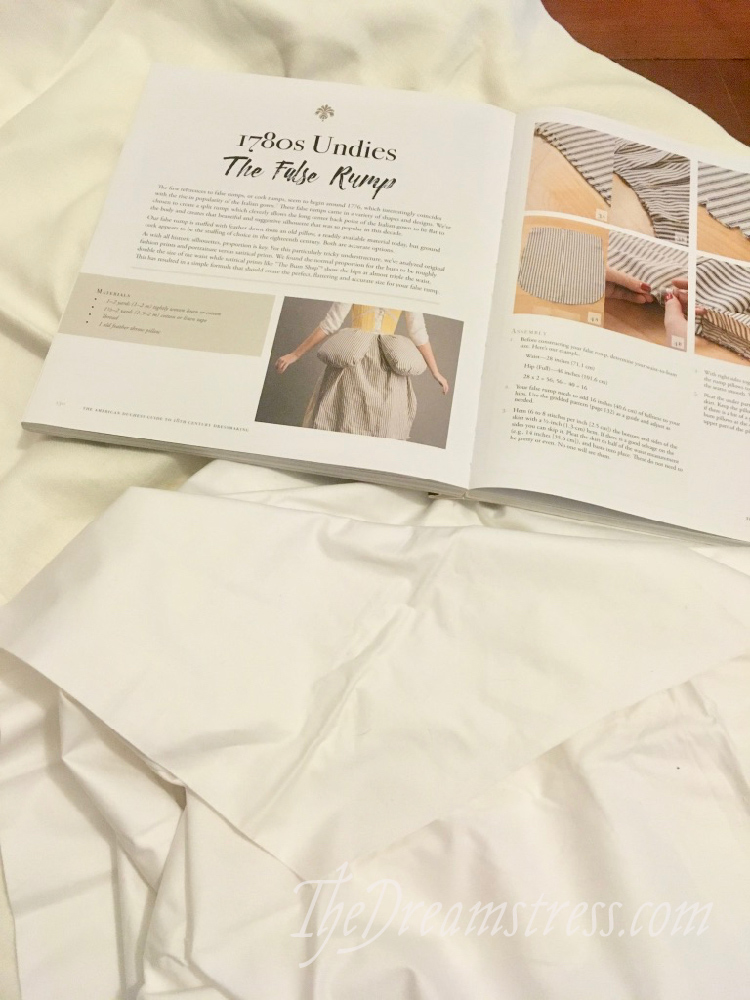
However, I have noticed it makes a slightly ‘corner-y’ bum, that pokes out in a square at the sides. It still looks amazing under anything with a full skirt, like an ‘Italian’ gown or a polonaise, but not so good if worn with a little jacket.
To see if I could make a less poke-y shape, I consulted Kendra’s great blog post, which has been the inspiration for most of my 18th c skirt support exploration. She doesn’t try this type of bum rump, but it’s still a great place to see how different shapes affect the silhouette, and to find many of the period quotes mentioning skirt supports in one place.
I also went back to the source of the AD tutorial, The Bum Shop:
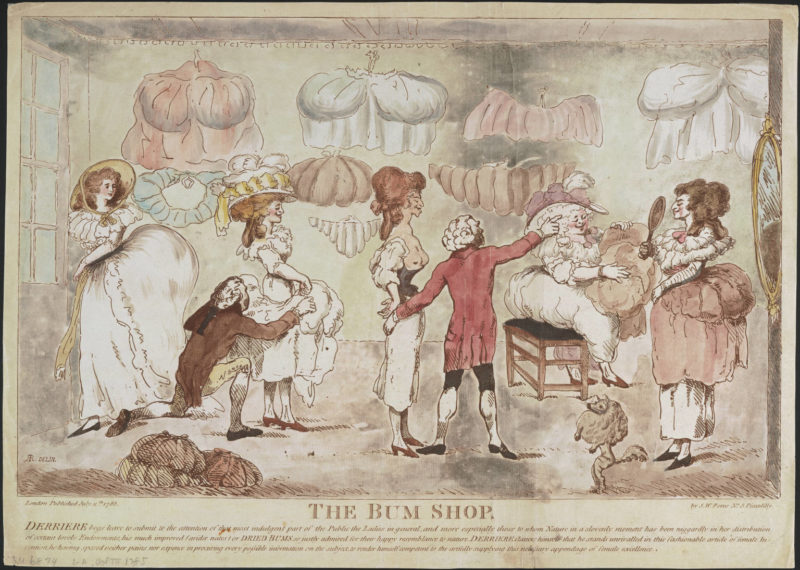
The three separate-bum rumps hanging on the top wall of the shop all have a much rounder, shorter silhouette than the AD pattern. Of course, it’s a satirical print: the artist was not a bum maker or patternmaker, and we can assume any shape would be exaggerated.
Slightly later, and showing a different type of bum enhancer (one which fascinatingly, seems to be built into drawers), is The Virgin Shapes Warehouse. It also shows a very round bum, but with these ones the padding has moved entirely to the back, with no fullness over the hips at all.
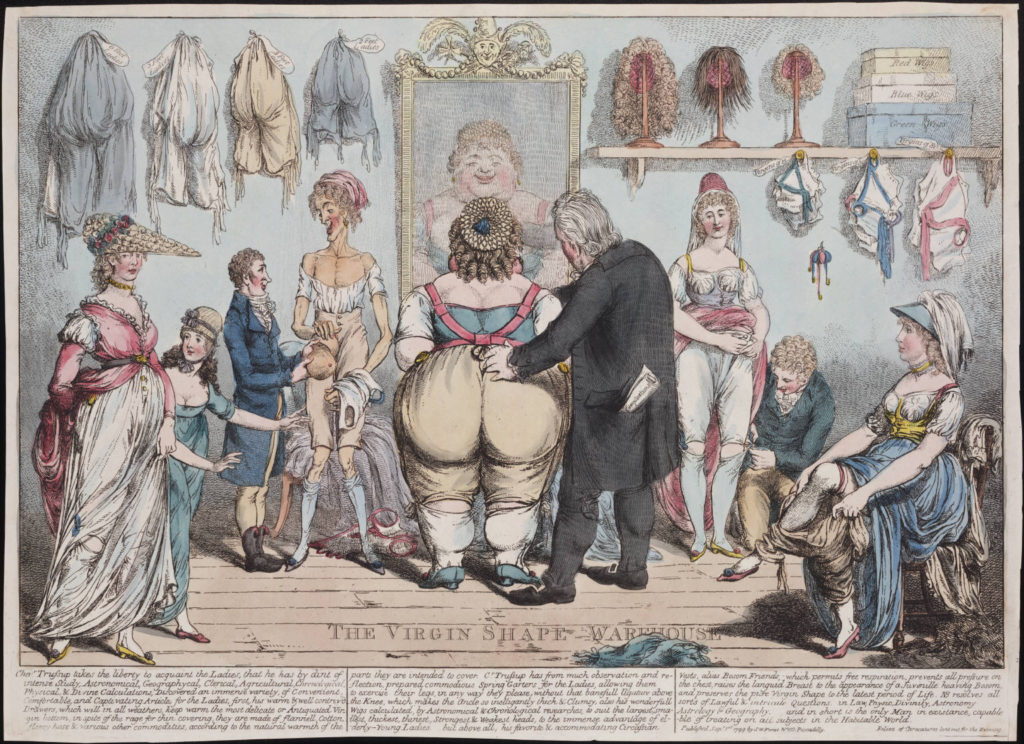
To get my shape, I cut out the pattern gives in the AD book and then trimmed away the corners until I got a shape that’s slightly more an oval, and less a rectangle with rounded corners (image shows the pieces partway through the process).
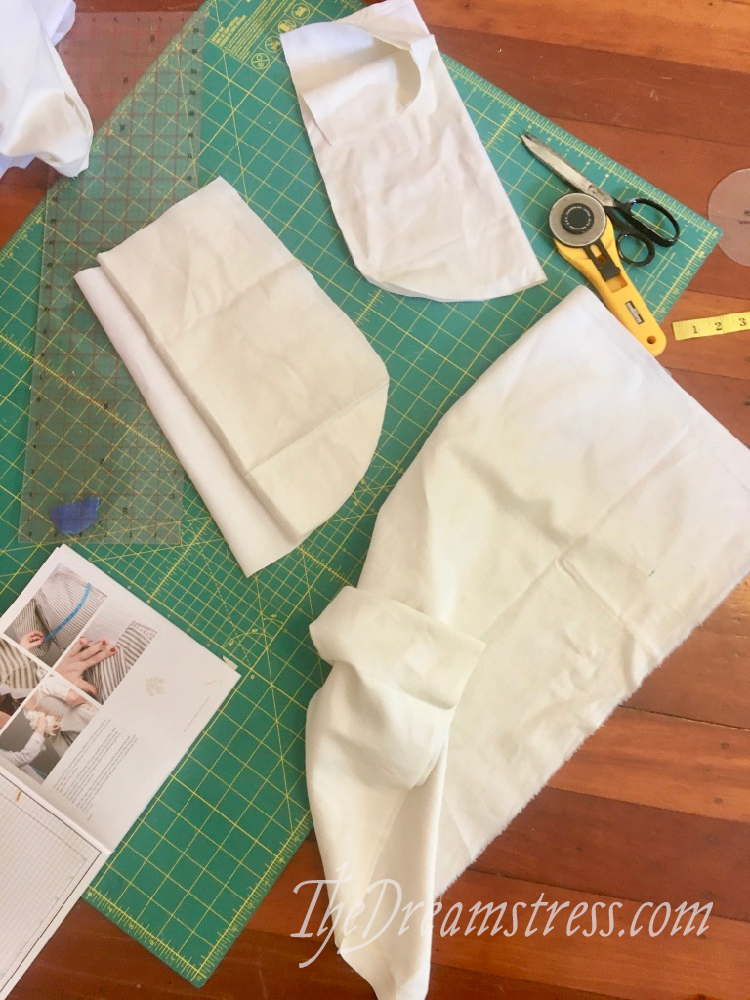
I was scared to do too much: if I do this again I’d make it even rounder, with no suggestion of corners at all.
Then it was on to lots and lots and lots of boring/meditative (depending on which way you look at it) hemming.
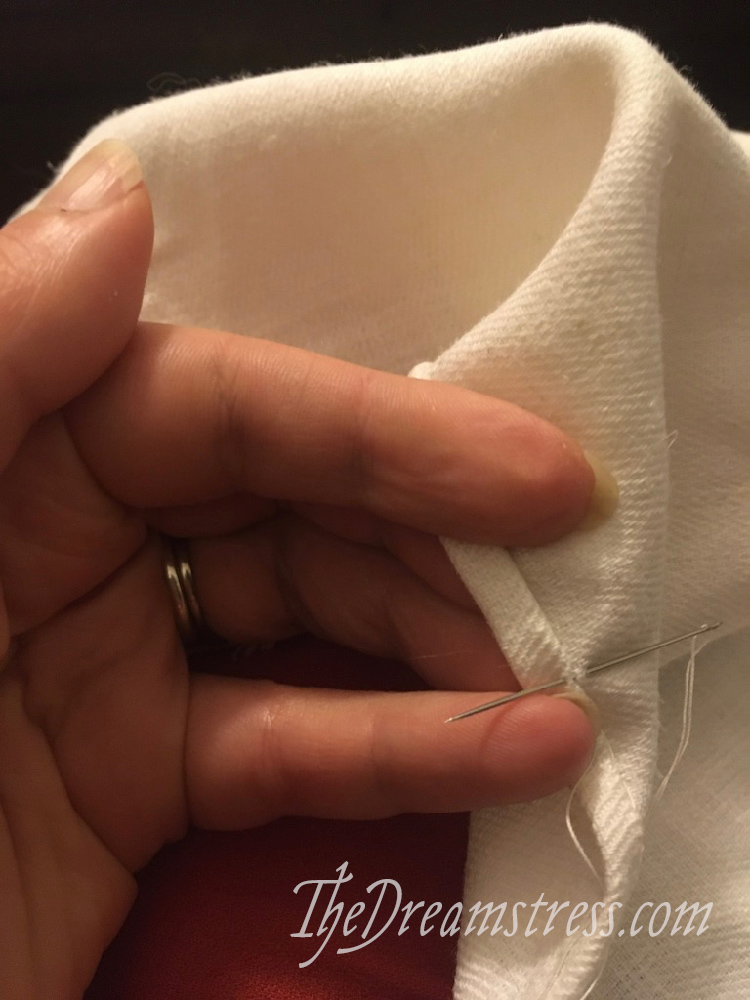
Then I sewed my bum cushions together, and turned them out. I’m using an inner bag of down-proof cotton fabric, and an outer bag of linen twill, for maximum non-scratchyness.
Then I pleated my half-petticoat on to my waistband, and pleated the bags on to that. The AD pattern says not to worry about what your pleating looks like, but I did some experimenting, and I think that the direction and placement of your petticoat and bag pleating does affect the final shape. By rearranging my pleats and where the fullness of the petticoat was concentrated I could get more or less bump in the centre of the ‘cheeks’, especially once I did some tacking.
With the pleating rearranged to my satisfaction, I stuffed:

I’d hoped to use wool rovings for my stuffing material, instead of feathers, but the source I’d used for earlier rumps is no longer supplying rovings, and I wasn’t able to find another source in time to get them before the lockdown, so I reverted to feathers and cannibalised my oldest/yuckiest feather pillow.

Feathers make a MESS!

Then I played with pleat placement on my bum-cheeks, and basted them in place.
Then it was on to finishing the waistband (definitely a job for a thimble).
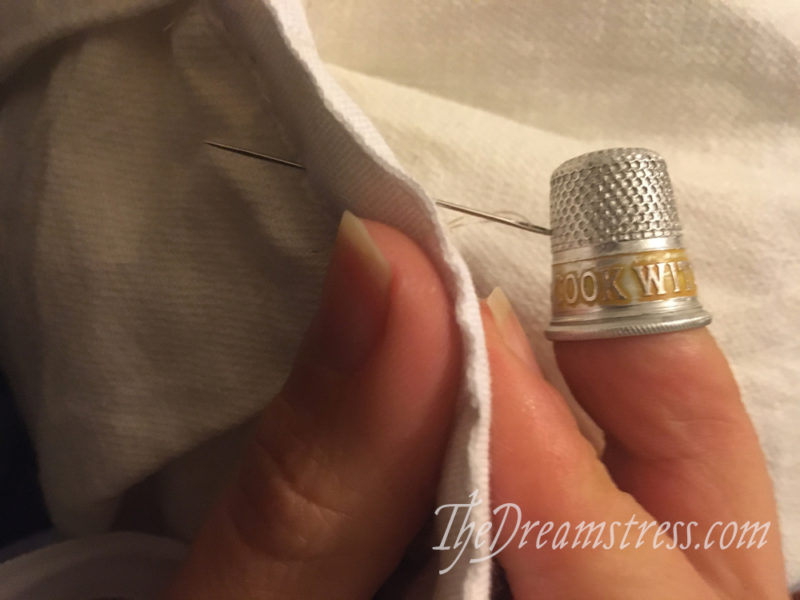
And hemming the ends of the waistband, which is always my favourite part, because you feel so incredibly virtuous hemming ends!
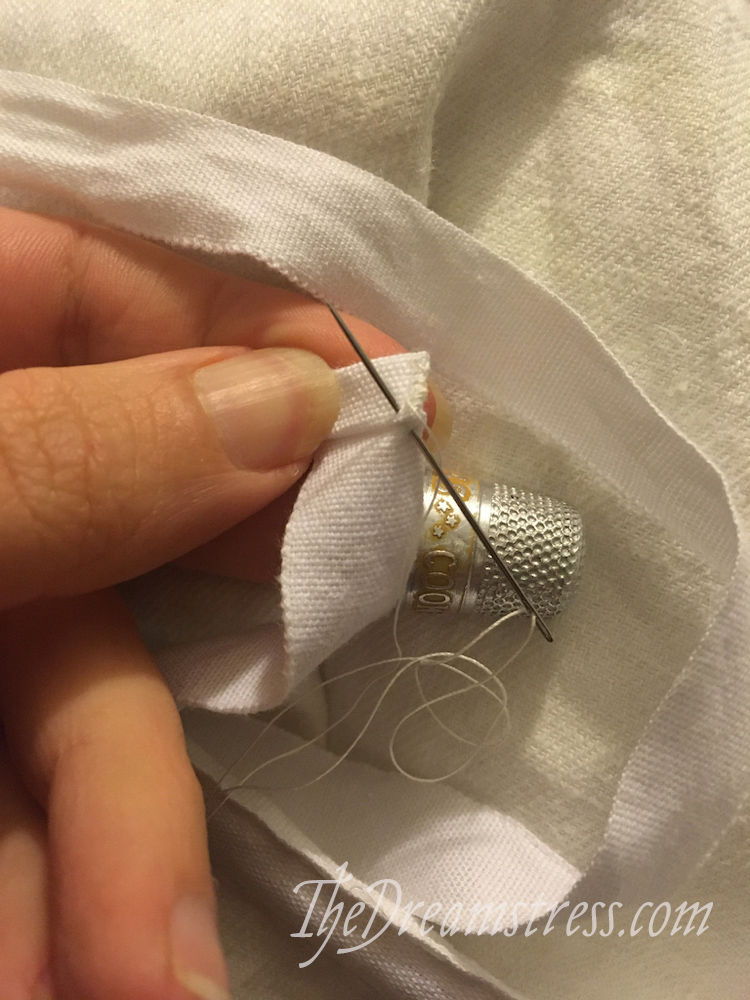
And done!
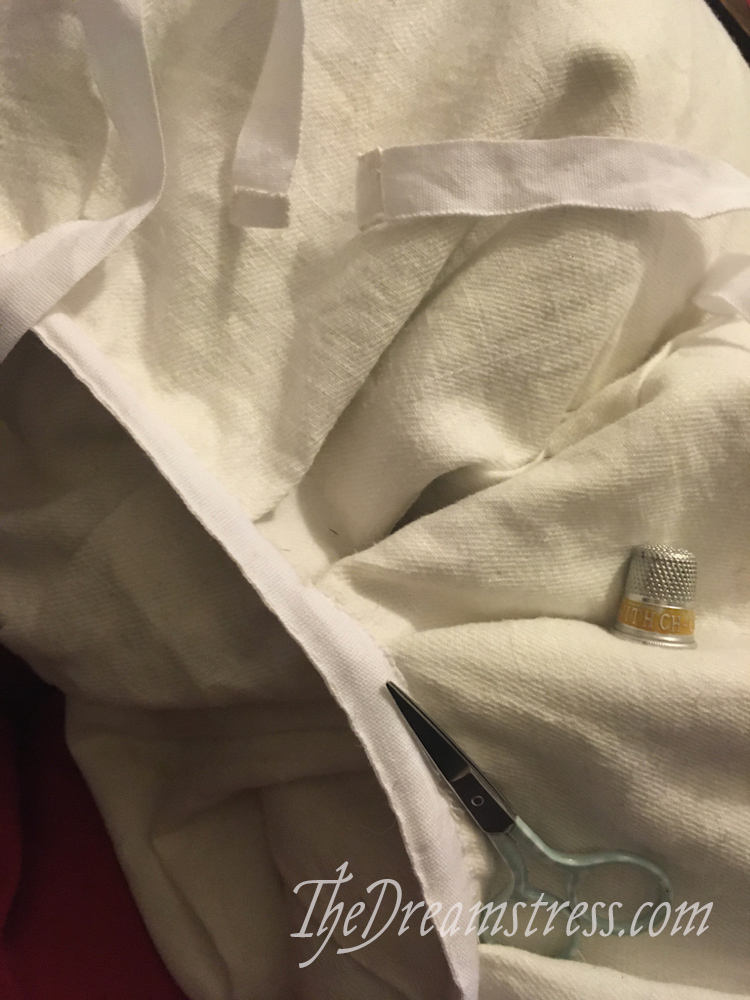
Well, actually, not quite. I put the bum rumps on my dressform and played with tacking the rumps to the half petticoat in places, to hold the corners down, and to hold the fullness in the desired position. Under a light (like a silk taffeta) petticoat it makes a definite difference.
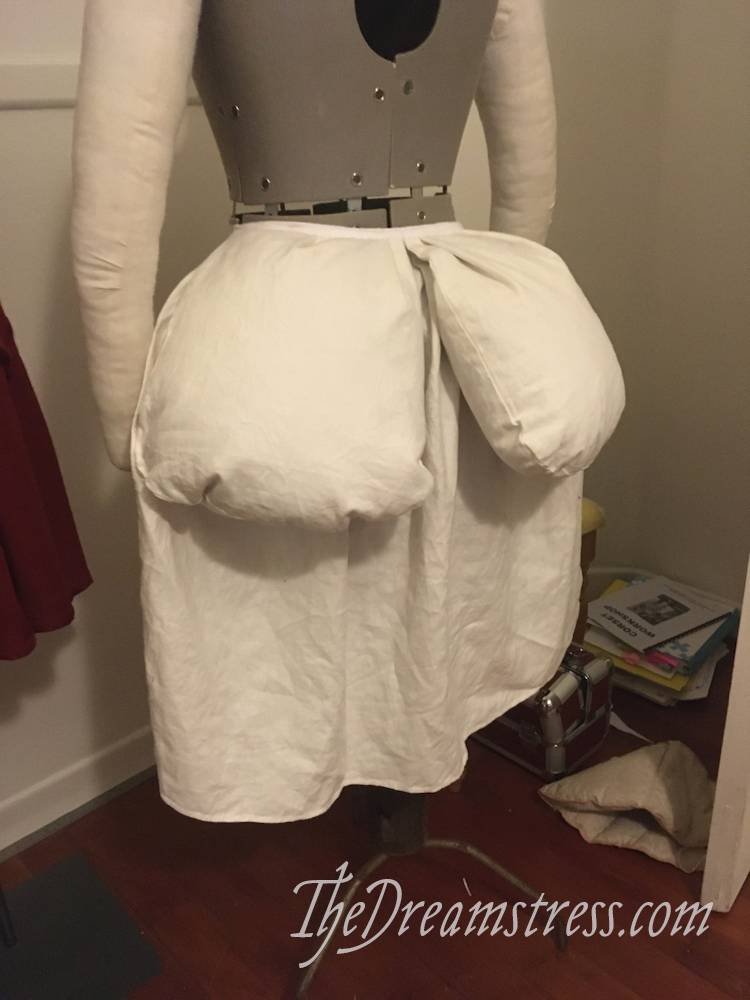
Questions people have asked:
What’s the point of the half petticoat?
Well, first, the only period source I know of for this style of bum rump (The Bum Shop) shows a half petticoat – and presumably they had a reason for it.
While I don’t always aim for strict historical accuracy with my costuming, I do find that at least trying to do things as close as possible to the way they were done in-period often teaches you a lot about why a garment was constructed that way, and can lead to better construction techniques. So, since the primary source shows a half petticoat, you should at least try one!
One obvious reason for the half petticoat is more protection from whatever you filled your bum rump with. The known historical filling is cork (ground), which presumably might be a bit scratchy (I’d love to try a ground cork bum some day, but only once I find a more efficient way to source it than collecting wine corks from friends and burning out a dozen blender engines). The AD book has you fill the rump with down – and eventually a few feathers will work through even very densely woven fabric and scratch. So another layer = less chance of itchy scratchy pokeys.
In making my rump and experimenting with shaping and rearranging fullness I also discovered the rump can be tacked to the petticoat in places, holding the fullness where you want it, and preventing that ‘corner-y’ look I so wanted to avoid.
Is it heavy?
It doesn’t feel heavy when I’m wearing it, but it certainly feels heavy when you pick it up!
According to my kitchen scale it weighs 726g or 1lb 9oz.
Why do you prefer to use wool instead of feathers?
Period sources describe cork rumps and rumps stuffed with crin (horsehair).
AD may have found an 18th c bum pad source that uses feather as a filler that I’m not aware of, or they suggests feathers based on the 1838 Workwoman’s Guide’s bustle pattern, which tells you to stuff a bum pad with “either swan’s or the best goose down”. While the book is half a century later than the rump, it does have many patterns and sewing techniques that are identical to 18thc ones, so it’s likely that feathers was a legitimate bum rump filler in the 18th c.
Wool is also closer to crin (a known 18th c rump filler) than feathers in how it behaves. Like crin it has loft, springiness, and the ability to be moulded into a shape which it holds for a long period (until it really gets compressed).
The weight is part of the reason I prefer to use wool as a stuffing: you get more loft for weight with wool than feathers.
Wool is definitely plausible for 18th c stuffings: any woman in the vicinity of a sheep farm would have had access to wool: especially the coarser, poorer quality stuff left over.
And finally, I live in NZ! Wool is what we do! All the sources for feathers/down I’ve found are imported from Asia. Using wool let’s me support a small local business, instead of a big multinational.
But this time I used feathers, because sometimes you make-do. And I enjoyed the opportunity to experiment with feathers. Someday I’ll make a wool one and really be able to compare how the two behave and wear.

Thanks to the ladies at American Duchess & Kendra at Demode for their awesome patterns, tutorials and research!
As a bonus, because I didn’t manage to buy wool rovings for this, it fits into the July 2020 HSM Challenge: No Buy
What the item is: A ca. 1785 Bum Rump
How it fits the challenge: The linen was inherited from a friends great-aunt, the feather-proof cotton came from a scrap bag someone gave me, the down was a cannibalised pillow. I did buy the thread and tape at op shops years ago, but there was no purchasing done for this challenge!
Material: linen twill, down proof cotton.
Pattern: the American Duchess 18th c Dressmaking book, and period sources.
Year: ca. 1785
Notions: cotton thread, cotton tape.
How historically accurate is it? It matches the one period image of a similar garment well, and the materials are all plausible. It’s unlikely the bum bags would have been double-layer in-period. 70% maybe?
Hours to complete: about 12
First worn: Only to fit a 1780s petticoat over it.
Total cost: $1 or less
* actually I lied. I can’t promise this won’t end up being used with a future Scroop + Virgil’s pattern 😜

interesting post…i have a bought false rump made of the usual cheap polyfill with no under-petticoat. i got it as a quick fix for a costume, intending to modify or replace it later; it is very…bouncy? and because not made to my size, it’s a bit wide for my frame. under-layers make ALL the difference in period costuming, don’t they?!
glad i am not the only person to have opened up a spare pillow for stuffing something…
i was wondering about the half petticoat feature; is it possible that the bum sections were, in period, tacked to it just as you did? as well as providing a barrier layer betwixt the wearer and any itchy/scratchy filling materials? because i noticed when wearing my crappy ‘bouncy’ bum, that safety-pinning it to the underskirt helped control its propensity to wiggle and also to want to shift about as i moved around.
as for filling, i imagine whatever was to hand would have been used, at least in home manufacture.
most of all, i find it so interesting to wear the clothing of a period when the fashion was to make a woman’s bum look bigger, rather than smaller…it’s such an intriguing change of perspective!
I knew you were lying that way. ;P
But then I don’t exactly mind because it’s historical sewing!
(Also I filled in my blog URL incorrectly for the comment above. Oops? :D)
I hope we’ll get to “see” it under something!
This sort of reminds me of padded shapewear. Instead of pinning the pad to the short petticoat, the pad is smoothed out by the stretchy fabric around it. Super interesting post. Thanks! (I’ve got some dryer lint, if that would work!)
If you can get hold of horsehair (and by that, I mean the stuff prepared for upholstery), do give it a try – it’s a completely different beast compared to sheeps’ wool, very dimensionally stable and springy, with zero propensity to felt, and without the warm (… hot … sweaty) feel you might get from wool. Also much lighter for volume.
(I’ve been felting and spinning and hoarding of fibres for textiles for some years; recently-ish, I got a sack of teased horsehair to redo an old chair, and was really surprised by that stuff)
And also – thanks for the really interesting post and the many, many at least equally interesting posts and patterns and ideas I’ve been consuming these last months – it’s always a treat to come by your blog!